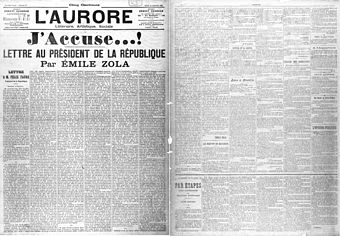Sunday, December 18, 2011
Sunday, November 13, 2011
"1906, Dreyfus rehabilitated" Online Exhibit
The Dreyfus Affair (which I've mentioned on this blog before) was an important catalyst for world Jewry, inspiring Theodor Herzl to organize early Zionists into a World Zionist Congress. There is a wonderful Alfred Dreyfus exhibit available here:
http://www.dreyfus.culture.fr/en/index.htm. It features a wealth of information, multimedia presentations, documents of the Dreyfus family, life in France in the 1890s, and news surrounding Dreyfus and his trials.
To explore the role of political cartoons in the public conversations surrounding the Affair, check out:
1906, Dreyfus rehabilitated : Caricatures - page 1
Dreyfus' trials revealed deep social injustice toward Jews, but they also revealed that not all non-Jews are anti-Semites. The most notable among the friends Jews found in this dark time is Emile Zola, who wrote a famous letter to the President of the Republic of France titled "J'Accuse!" (I accuse!), published in a major newspaper. You can find a wiki document featuring the original article and its translation here: http://en.wikisource.org/wiki/J%27accuse.
http://www.dreyfus.culture.fr/en/index.htm. It features a wealth of information, multimedia presentations, documents of the Dreyfus family, life in France in the 1890s, and news surrounding Dreyfus and his trials.
To explore the role of political cartoons in the public conversations surrounding the Affair, check out:
1906, Dreyfus rehabilitated : Caricatures - page 1
Dreyfus' trials revealed deep social injustice toward Jews, but they also revealed that not all non-Jews are anti-Semites. The most notable among the friends Jews found in this dark time is Emile Zola, who wrote a famous letter to the President of the Republic of France titled "J'Accuse!" (I accuse!), published in a major newspaper. You can find a wiki document featuring the original article and its translation here: http://en.wikisource.org/wiki/J%27accuse.
Labels:
anti-semitism,
articles,
Dreyfus,
ethics,
Herzl,
history,
Israel,
palestine,
sixth grade,
Zionism
Tel Aviv Fashion Week. November 21-23, 2011 – Tourist Israel Travel Guide
With thanks to Hannah, in my Etz Chayim Sixth Grade Class, check out this blurb about this exciting economic and artistic showcase in the coming weeks:
Tel Aviv Fashion Week. November 21-23, 2011 – Tourist Israel Travel Guide
For more information about the events of Tel Aviv Fashion Week, check out:
http://www.haaretz.com/print-edition/news/tel-aviv-gets-its-style-on-as-fashion-week-makes-roaring-return-1.391826
http://blogs.forward.com/the-shmooze/138978/
Tel Aviv Fashion Week. November 21-23, 2011 – Tourist Israel Travel Guide
For more information about the events of Tel Aviv Fashion Week, check out:
http://www.haaretz.com/print-edition/news/tel-aviv-gets-its-style-on-as-fashion-week-makes-roaring-return-1.391826
http://blogs.forward.com/the-shmooze/138978/
Thursday, October 27, 2011
Tuesday, October 25, 2011
Sunday, October 9, 2011
Moroccan Jews Making Changes to America's Quintissential Ashkenazic Institution--Manishewitz
With Some Passing on Gefilte Fish, A New Lure: Fish 'Meatballs'
Manischewitz Takes Mediterranean Turn, Hoping to Spice Up Fare; 'What Is Cumin?'
By LUCETTE LAGNADO
For years, gefilte fish—plump little patties of minced fish—has been the Jewish holiday treat that some Jews love to hate.
These days, some say they've moved on. "Tradition is important but it needs updating—it doesn't have to be only about gefilte fish anymore," says Chany Konikov, a rabbi's wife in Southampton, N.Y., who also likes poached salmon and sushi.
Even Paul Bensabat wasn't that impressed when he tried it. "Boring," he says. "Pretty bland." And he's co-CEO of Manischewitz Co., one of the largest producers of gefilte fish. When Mr. Bensabat and partners took over the 123-year-old company, they decided to spice things up. One idea: Moroccan fish balls.
For more:With Some Passing on Gefilte Fish, Manischewitz Tries a New Mediterranean Lure - WSJ.com
Sunday, October 2, 2011
Awe-Inspiring Spectacle of the Yom Kippur Ritual of the Temple
Here are some sites from today's Etz Chayim sixth grade lesson on the awe-inspiring spectacle of the Yom Kippur Ritual of the Temple.
First we looked at http://www.sci.brooklyn.cuny.
Next, we looked at the Israel Museum in Jerusalem's Interactive Second Temple Model (http://www.english.imjnet.org.
We concluded by opening a discussion (which we will continue on Wednesday) about what the purposes of the Temple sacrifices were (referencing http://www.jewfaq.org/
First we looked at http://www.sci.brooklyn.cuny.
Next, we looked at the Israel Museum in Jerusalem's Interactive Second Temple Model (http://www.english.imjnet.org.
We concluded by opening a discussion (which we will continue on Wednesday) about what the purposes of the Temple sacrifices were (referencing http://www.jewfaq.org/
Labels:
Beit Hamiqdash,
bible,
High Holy Days,
history,
Israel,
korbanot,
sacrifices,
sixth grade,
Temple
Tuesday, September 27, 2011
High Holy Day Music from throughout the Jewish World JNUL - Jewish National & University Library
As we start another year of studies, I invite my students and their families to check out this wonderful database of Jewish music from around the world for Selichot, Rosh Hashanah, and Yom Kippur.
JNUL - Jewish National & University Library
JNUL - Jewish National & University Library
Labels:
ashkenazim,
Beta Israel,
customs,
Ethiopia,
God,
High Holy Days,
holidays,
ladino,
mizrahim,
music,
prayer,
sephardim,
seventh grade,
teshuvah,
yemen,
yemenite
Thursday, July 28, 2011
Saturday, March 5, 2011
Tuesday, February 22, 2011
Fit for the eaters AND fit for the workers
"Kasher" literally means (in Hebrew) "fit" or "suitable." Generally, this has been interpreted as meaning "fit for eating." Today, there are important campaigns within multiple Jewish denominations (including the denominations most committed to traditional kashrut, Conservative and Orthodox Judaism) to make food fit for the animals who feed us and for the workers who prepare and serve our food. Here's an article about new certification processes for ethical labor standards.
Kosher establishments pledge ethical labor standards - chicagotribune.com
Kosher establishments pledge ethical labor standards - chicagotribune.com
Sunday, February 20, 2011
Article from The Guardian about growing up on a kibbutz
This article by Noam Shpancer highlights themes shared my sixth grade classroom by a parent who also grew up on a kibbutz. It is critical of the practice of raising children in "Children's Houses" and talks about how kibbutzim today are different.
Child of the collective | Life and style | The Guardian
Child of the collective | Life and style | The Guardian
Thursday, January 20, 2011
Subscribe to:
Comments (Atom)


